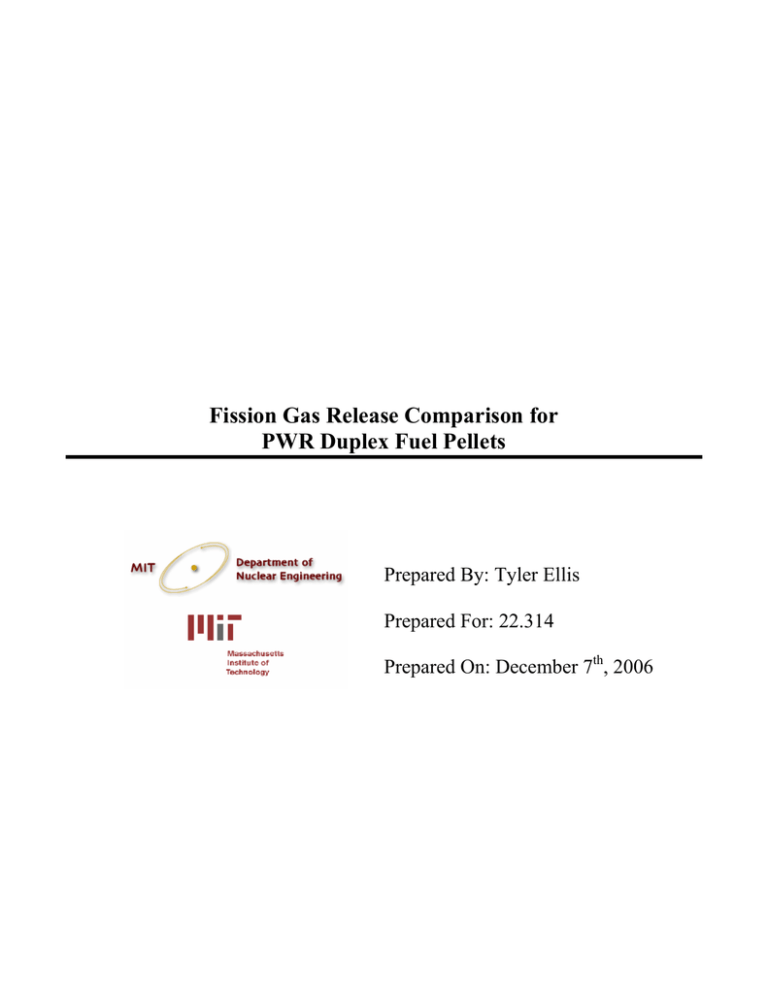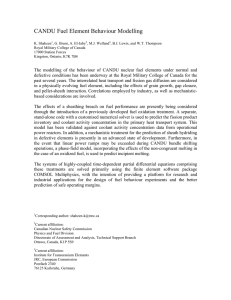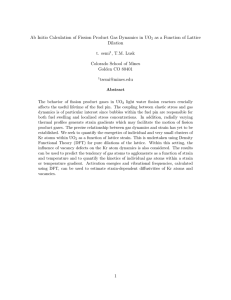Fission Gas Release Comparison for PWR Duplex Fuel Pellets Prepared For: 22.314
advertisement

Fission Gas Release Comparison for PWR Duplex Fuel Pellets Prepared By: Tyler Ellis Prepared For: 22.314 Prepared On: December 7th, 2006 Abstract Current research has identified Duplex pellets as an effective strategy for decreasing the centerline temperature of the fuel. However, before this design can be widely utilized several areas, including fission gas release, need to be better characterized. Therefore, this paper seeks to ascertain the relative difference in fission gas release between a standard solid UO2 reference design and a duplex design with Zircaloy and UO2. Although the central area in the duplex doesn’t produce any fission gas, it is not well known if the higher temperatures in the outer annulus (when compared to the equivalent area in the solid design) will cause overall more or less fission gas release. Interestingly, this study concluded that the duplex fuel actually exhibits a 4.4% higher overall fission gas release when compared to the solid fuel. Due to the very approximate treatment of several important input variables it was concluded that while the duplex design does have lower average temperatures, the fission gas release is comparable to that of the solid fuel design. Introduction One of the difficulties facing nuclear fuel designers today is ensuring that the design stays below the melting point of the fuel or 2840°C in the case of UO2. Recent work has shown that a significant thermal operating benefit can be obtained from the incorporation of annular fuel as shown in Figure 1 below. Solid fuel rod 17x17, q'=45kW/m Annular fuel rod 13x13, q'=74kW/m Annular fuel rod 13x13, q'=111kW/m 2400 2200 Assumptions: -Hot spot linear powers -Same core peaking of 2.5 -Same core power for 45kW/m and 74kW/m cases 2000 Temperature ( oC) 1800 1600 1400 1200 1000 P=150% 800 600 400 200 0 1 2 3 4 5 6 7 8 Radius (mm) Figure 1: Solid/Annular Radial Fuel Temperature Profile (Kazimi) These annular pellets obtain this additional thermal margin due to the unique internally and externally cooled geometry of the individual fuel pins shown in Figure 2 below. Coolant Fuel Cladding Gap Traditional fuel pin with solid pellets Annular fuel pin with annular pellets Figure 2: Annular Fuel Pin Geometry (Kazimi) Besides the increased surface area for heat transfer, the annular pellets also benefit from not having fuel in the center of the pin which effectively spreads out the heat source. Due to fabricability concerns, additional schemes such as Duplex pellets have also been proposed in order to decrease the centerline temperature. Duplex pellets differ from annular fuel in that the inner hole of the annular pellet is filled with a solid material such as ZrO2 or Zircaloy-4 as shown in Figure 3. Figure 3: Duplex Fuel Pin Geometry Like nearly all ideas within the nuclear field, the duplex pellet concept is not new. Duplex pellets were originally proposed during the late 1970’s light water reactor breeder program in hopes of increasing the breeding potential of the fissile material. However, its use has started to recently resurrect due to increased interest in proliferation resistance (Shwageraus) and waste management (Bays). Shwageraus utilized this geometry as one possible avenue in order to help develop a thorium-based fuel cycle for light water reactors which reduces the plutonium generation rate and enhance the proliferation resistance of the spent fuel. However, due to the significantly large thermal resistance path from the UO2 in the center to the ThO2 on the periphery, it was found that the design led to higher than acceptable centerline temperatures. Bays, on the other hand, took advantage of this characteristic by putting spent fuel in a zirconium metal matrix on the periphery with thoria/zirconium CERMET in the center. This design allowed for a deeper burn of the transuranic waste because of the higher burnup “rim effect” on the periphery from the high thermal flux coming in from the moderator. Additionally, since the CERMET shares a common metallic phase with the outer pellet, these two can be co­ extruded together with the zircaloy cladding in a heated die extrusion process. However, in order to further develop this duplex fuel pin design, there are several areas, including fission gas release, which need to be better characterized. Therefore, this paper seeks to ascertain the relative difference in fission gas release between a standard solid UO2 reference design and a duplex design with Zircaloy and UO2. Although the central area in the duplex doesn’t produce any fission gas, it is not well known if the higher temperatures in the outer annulus (when compared to the equivalent area in the solid design) will cause overall more or less fission gas release. Method For purposes of this study, an equivalently sized solid UO2 reference pellet will be compared with a UO2/Zircaloy duplex pellet. In order to make a constant comparison, the linear heat generation rate for the two designs will be matched. This necessitates that the UO2 in the outer ring of the duplex pellet will have to be enriched above that of the 5 weight % UO2 in the solid pellet. The particular calculations showing this determination follow in the next section. The next step will be to determine the temperature profiles for the two respective designs. For simplicity in the calculation, the thermal conductivity of the UO2 will be assumed constant. This will allow the establishment of average temperature values for both the inner and outer zones. These temperature averaged zones will then be fed into a fission gas release correlation based on Booth type diffusion with grain boundary gas accumulation and resolution (Weisman). In order to perform the fission gas estimation, this correlation also requires several other input parameters including, discharge burnup of the fuel, total in-core residence time and plutonium content. A CASMO simulation of both the solid reference fuel case as well as the duplex fuel case allowed these parameters to be determined. The pellet design parameters used to construct the CASMO input deck are shown below in Table 1. Dco (mm) Dci (mm) Dfo (mm) Dfi (mm) Solid Pellet 9.52 8.37 8.25 - Duplex Pellet 9.52 8.37 8.25 2.74 Table 1: Fuel Pin Design Parameters The solid reference fuel was ran with 5 weight percent enrichment however in order to fairly compare the duplex fuel, the total number of U235 atoms needs to be equivalent on a per unit length basis. Therefore the following calculation was performed to determine the enrichment of the duplex fuel. 10.4gU 1molUO2 gU 1molU 238gU * * * = 9.1674 3 3 cm 270gUO2 1molUO2 1molU cm gU gU 235 9.1674 3 * 0.05 = 0.45837 cm cm 3 The area ratio between the duplex and solid fuel is given by AR = π (4.125mm) 2 π ((4.125mm) 2 − (1.370mm) 2 ) = 1.10834 Thus multiplying the U235 atom density by the area ratio gives gU 235 gU 235 0.45837 *1.10834 = 0.50803 cm 3 cm 3 Dividing this by the total original U atom density gives the new enrichment gU 235 cm 3 = 5.54% gU 235 9.1674 cm 3 0.50803 The density was determined by 1 1 )( ρUO2 ) + (1 − )( ρ Zircaloy ) AR AR g g g = (0.90225)(10.4 3 ) + (0.09775)(6.44 3 ) = 10.01 3 cm cm cm ρ duplex = ( Figure 4 shows a plot of the Eigenvalue versus burn-up of the two designs. The simulation assumed a 3 batch refueling scheme with 3% leakage. The calculated discharge burn-ups are indicated on the graph by the arrows from the x-axis as well as in Table 2. Keff versus In-core Life for Solid and Duplex Fuel Pins 1.5 1.4 1.3 1.2 Keff Solid Pin Duplex Pin 1.1 1 0.9 0.8 0 10 20 30 40 50 56 60 63 70 80 Burnup (MWd/kg) Figure 4: Keff versus In-Core Life for Solid and Duplex Fuel Pins Discharge BU (MWd/kg) Discharge BU (MWs/kg) Specific Power (W/g) EFPD EFPs Solid Fuel Duplex Fuel 56.25 63.75 4860000 5508000 0.0343346 0.0395727 1638.289073 1610.95907 141548175.9 139186863.7 Table 2: CASMO Calculated Discharge Parameters Calculations First the linear power ratings will be matched between the two designs. ' ' qsolid = qduplex ' ''' qsolid = π (R 2fo − R 2fi )qduplex ''' qduplex = 1.1228*106 W m3 Then the volumetric heat generation rate for the solid fuel is ''' = qsolid q ' solid 2 fo πR kW W m = = 1.03855*106 3 2 m π (0.0040456m) 53.4 In order to determine the temperature distribution in the fuel pins we start with the general heat conduction equation as below -V * q '' + q ''' = 0 which at steady state and assuming we are only considering one dimension in the radial direction, the heat conduction equation reduces to 1 d ⎛ dT ⎞ ''' ⎜ kr ⎟+q =0 r dr ⎝ dr ⎠ k dT r C + q ''' + 1 = 0 dr 2 r Now we write the general heat flux condition knowing that for the duplex pellet no heat flux exists at Rfi and for the solid pellet Rfi=0 q which gives '' r=R fi dT = −k dr = 0 Î C1 = − r=R fi q ''' R 2fi 2 ∫ T max T kdT = ⎛ r ⎞ q ''' 2 ⎟ r − R 2fi + C1 ln⎜ ⎜ R ⎟ 4 fi ⎝ ⎠ [ ] Since Rfi=C1=0 for the solid fuel, the above expression simplifies to T max ∫ T q ''' r 2 kdT = 4 Then evaluating the expression at r=Rfo we find T max ∫ Tfo kdT = q' 4π Plugging the in numbers (assuming that Tfo=400°C) gives ⎛ W ⎞ ⎜ 3 ⎟(Tmax ⎝ m°C ⎠ ⎛ 3W ⎞ ⎜ 53.4 *10 ⎟ m ⎠ − 400 °C ) = ⎝ Î T max = 1816.48 °C 4π However, for the duplex pellet we substitute in the expression for C1 and solve ∫ T max T T max ∫ T kdT = q ''' R 2fi ⎛ r ⎞ q ''' 2 ⎟ ( r − R 2fi ) − ln⎜ ⎜ R ⎟ 4 2 ⎝ fi ⎠ 2 2 2 q ''' r 2 ⎛⎜ ⎛⎜ ⎛ R fi ⎞ ⎞⎟ ⎛ R fi ⎞ ⎛⎜ r ⎞⎟ ⎞⎟ kdT = 1 − ⎜ ⎟ − ⎜ ⎟ ln ⎟ ⎟ 4 ⎜ ⎜ ⎜⎝ r ⎟⎠ ⎟ ⎜⎝ r ⎟⎠ ⎜ ⎝ R fi ⎠ ⎠ ⎠ ⎝ ⎝ Then evaluating the expression r=Rfo and substituting q ''' R 2fo = q' ⎛ ⎛ R ⎞ 2 ⎞ π ⎜1 − ⎜⎜ fi ⎟⎟ ⎟ ⎜ ⎟ R ⎝ ⎝ fo ⎠ ⎠ ⎛ ⎛ ⎛ R ⎞ ⎞⎞ ⎜ ⎜ ⎜ fo ⎟ ⎟ ⎟ ln ' ⎜ ⎟⎟ R fi ⎟ T max q ⎜ ⎜ ⎜ ⎝ ⎠ ∫ Tfo kdT = 4π ⎜1 − ⎜⎜ ⎛ R ⎞2 ⎟⎟ ⎟⎟ ⎜ ⎜ ⎜ fo ⎟ −1 ⎟ ⎟ ⎟ ⎟ ⎜ ⎜ ⎜ R ⎟ ⎠ ⎠ ⎝ ⎝ ⎝ fi ⎠ Plugging in the numbers (assuming that Tfo=400°C) gives we find ⎛ ⎛ ⎛ 4.125mm ⎞ ⎞ ⎞ ⎛ 3 W ⎞ ⎜ ⎜ ln⎜ ⎜ 53.4 *10 ⎟ ⎟ ⎟⎟ m ⎠ ⎜ ⎜ ⎝ 1.37 mm ⎠ ⎟ ⎟ ⎛ W ⎞ ⎝ ⎜3 ⎟(Tmax − 400 °C ) = 2 ⎜1 − ⎜ ⎟ ⎟ Î T max = 1603.11 °C 4π ⎝ m°C ⎠ 4.125mm ⎛ ⎞ ⎜ ⎜ ⎜ ⎟ ⎟ ⎜ ⎜ ⎝ 1.37mm ⎟⎠ −1 ⎟ ⎟ ⎠ ⎠ ⎝ ⎝ Figure 5 below shows the plotted fuel pin temperature profile and the breakdown between Zone 1 and 2. The temperature averaged values for Zones 1 and 2 are shown in Table 3. Fuel Pin Temperature Profiles 1900 Zone 1 1800 Zone 2 1700 1600 y = -440.7x + 2206.9 1500 1400 y = -345.48x + 1816.5 Temp (C) 1300 Solid Pin Duplex Pin Linear (Duplex Pin) Linear (Solid Pin) 1200 1100 1000 900 800 700 600 500 400 0 0.5 1 1.5 2 2.5 3 3.5 4 Radius from Fuel Pin Center (mm) Figure 5: Fuel Pin Temperature Profiles Avg Temp Zone 1 (°C) Avg Temp Zone 2 (°C) Solid Pellet Duplex Pellet 1698.17 1603.11 989.94 1001.52 Table 3: Zone Averaged Temperatures 4.5 This zone averaged temperature profile for both the solid and duplex fuel is depicted below in Figure 6. Figure 6: Zone Averaged Temperature Profiles Now that the relevant data has been determined, we can start to calculate the fission gas release. Provided b=burn-up in MWs/kg and t=cycle length in s, we calculate the high burn-up factor as 1.25*1014 bunkel = ⎛ ⎛ b ⎞3 ⎞ ⎟ ⎜⎜ ⎜ ⎝ 86.4 ⎟⎠ ⎟ ⎠ ⎝ The fuel grain fission gas release is calculated by ⎛ −45289.86 ⎞ ak1 = 9 *10 ⎜ e ftemp ⎟ + 0.0005 ⎜ ⎟ ⎝ ⎠ 7 ⎞ ⎛ ⎟ ⎜ ⎟ ⎜ 1 ⎟ ⎜ ak2 = 0.00005* ak1* 1 − ⎛ ftemp−1900 ⎞ ⎜ ⎛ ⎜⎝ 40 ⎟⎠+1 ⎞ (−bunkel ) ⎟ ⎟ + e ⎟ ⎜ ⎜⎜ e ⎟ ⎜ ⎟ ⎝ ⎠ ⎠ ⎝ ⎛ (1 − e −ak 2*t ) ⎞ ⎟⎟ f = (1 − (1 − ak1)) * ⎜⎜ ⎝ ak 2 * t ⎠ fma = f * fmgpr + cc2 * (1 − e −ak 2*t ) where ftemp is the temperature, fmgpr is the input fission gas produced (moles), and cc2 is the specified concentration of grain trapped fission gas. Now assuming that gbbgi is the specified concentration of grain boundary trapped fission gas, the fission gas not released from the grain boundary can be calculated as gbbg = gbbgi + fma Assuming that comp is the specified plutonium content, fdens is the specified fuel density in kg/m3 and fgrn is the specified fuel grain size in microns, the grain boundary fission gas release is given by roth = 11.45* comp ⎛ comp ⎞ * ⎜1 − ⎟ *10.96 100 ⎝ 100 ⎠ fp = 1 − 0.001* p= fdens roth 1 ⎛ ⎛ 1 ⎞ 105 ⎞ ⎟ ⎜⎜1 + ⎜⎜ −1⎟⎟ * 3 ⎟ ( ) fp fgrn ⎠ ⎝ ⎝ ⎠ fbr = (1 − erff ( p) ) + e −bunkel where the error function is approximated by erff (x) = 1 − 0.348024 * 1 (1 + 0.47047 * x ) 1 ⎛ ⎞ + 0.0958798* ⎜ ⎟ ⎝ 1 + 0.47047 * x ⎠ 2 1 ⎞ ⎛ − 0.7478556 * ⎜ ⎟ 1 + 0.47047 * x ⎝ ⎠ + 0.000025 3 Finally by defining cc1 as the output concentration of grain trapped fission gas, gbgout as the output concentration of grain boundary trapped fission gas and fmgrot as cumulative fission gas released we can calculate fmaa = fbr * gbbg cc1 = cc2 + fmgpr − fma gbgout = gbbg − fmaa fmgrot = fmgr + fmaa Results The calculations showed that the outer fueled annulus did indeed exhibit a significantly higher fission gas release that the equivalent region for the reference solid pellet. Since the fuel is being compared on a per unit length basis, the fission gas release results are organized into area weighted ratios as shown below in Table 4. Solid Pellet Weighted Fission Gas Release Zone 1 Weighted Fission Gas Release Zone 2 Duplex Pellet Weighted Fission Gas Release Zone 1 Weighted Fission Gas Release Zone 2 3.23% 21.06% 0.00% 25.37% Table 4: Weighted Fission Gas Release Ratios Thus the final fission gas release ratios for the solid reference and duplex fuel can be easily calculated and are given below in Table 5. Zone 2 Fission Gas Release Ratio 1.2046 Total Fission Gas Release Ratio 1.0443 Table 5: Final Fission Gas Release Ratios As shown above, the 20.4% higher fission gas release in the duplex fuel designs outer annulus more than compensates for the larger fission gas release which occurs in Zone 1 of the solid reference fuel. Overall, the 4.4% higher fission gas release for the duplex fuel is not significantly larger than that of the solid reference. However, this result is surprising in that it goes against the conventional wisdom of a lower centerline temperature always yielding a lower cumulative fission gas release. Conclusions Since this was a scoping study, the treatment of several variables was fairly rough. Aside from treating the thermal conductivity as non constant, the analysis could also be further refined by considering a larger number of temperature averaged cylinder zones. The 4.4% difference in fission gas release determined in this scoping study is likely to be overshadowed by the uncertainties in the analysis. Thus it would be safe to conclude that while the duplex design does have lower average temperatures, the fission gas release is comparable to that of the solid fuel design. References Kazimi, M., Hejzlar, P., “High Performance Fuel Design for Next Generation PWRs: Final Report,” MIT Center for Advanced Nuclear Energy Systems, MIT-NFC-PR-082, January 2006. Shwageraus, E., et. al, “Microheterogenous Thoria-Urania Fuels for Pressurized Water Reactors,” Nuclear Technology, Volume 147, July 2004. Bays, S., “Evaluation of Recent Transmutation Scenarios for Partitioning/Transmutation of Actinides: A Once Recycle Commercial Waste Disposition Fuel Cycle Utilizing Thorium,” Idaho National Laboratory, p 725-6. Weisman, J., MacDonald, P., “Fission Gas Release Correlation,” ANS Transactions, Volume 12, Number 2, November 1969. Pacific Northwest National Laboratory, “FRAPCON-3: A Computer Code for the Calculation of Steady-State, Thermal-Mechanical Behavior of Oxide Fuel Rods for High Burnup,” NUREG/CR-6543, Volume 2, PNNL-11513, December 1997.







